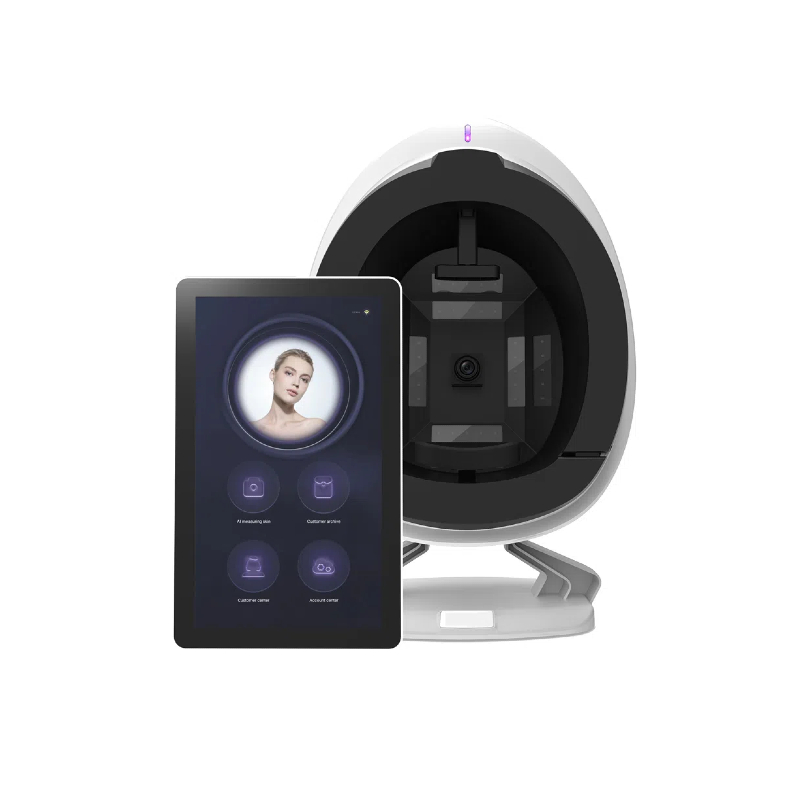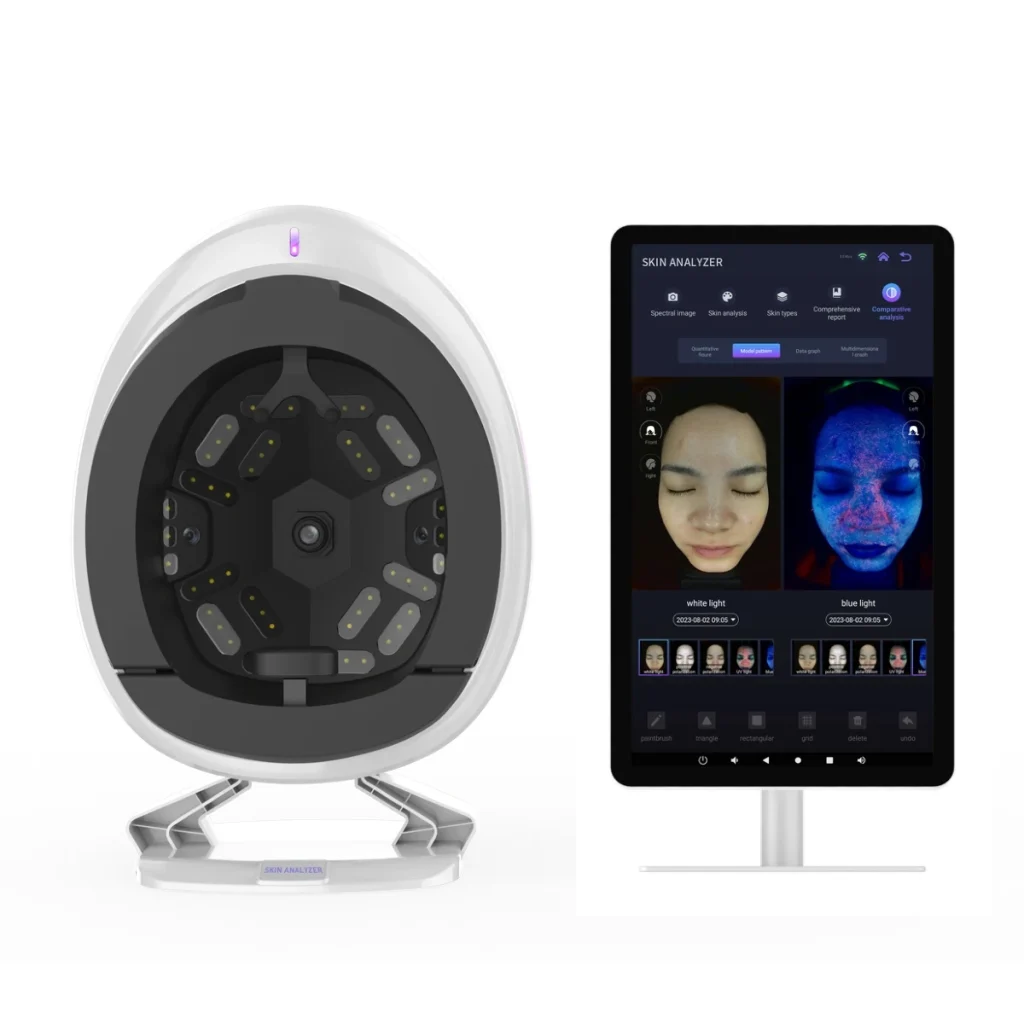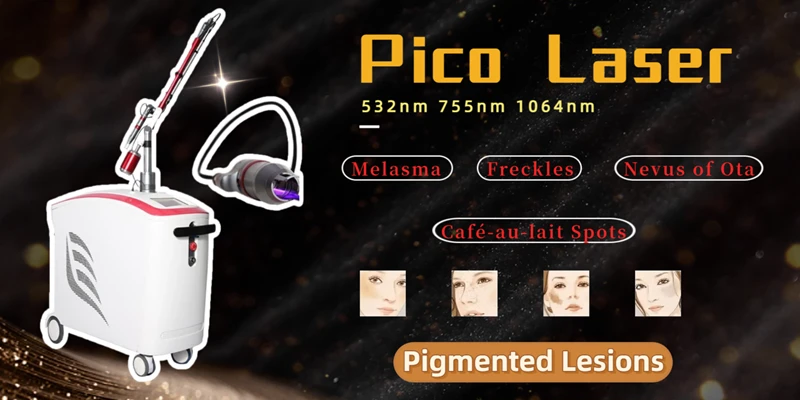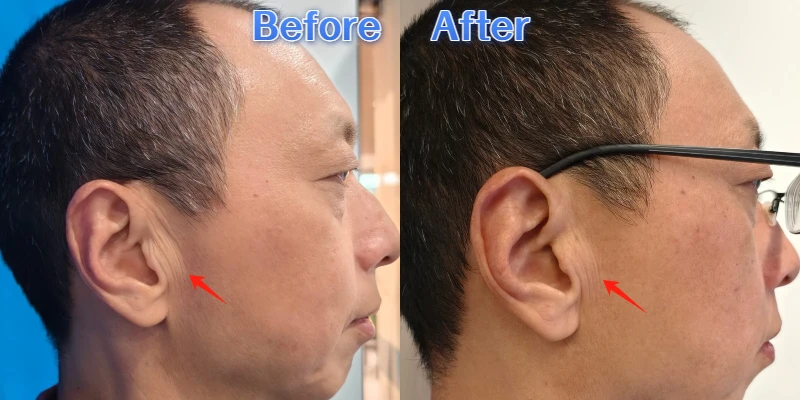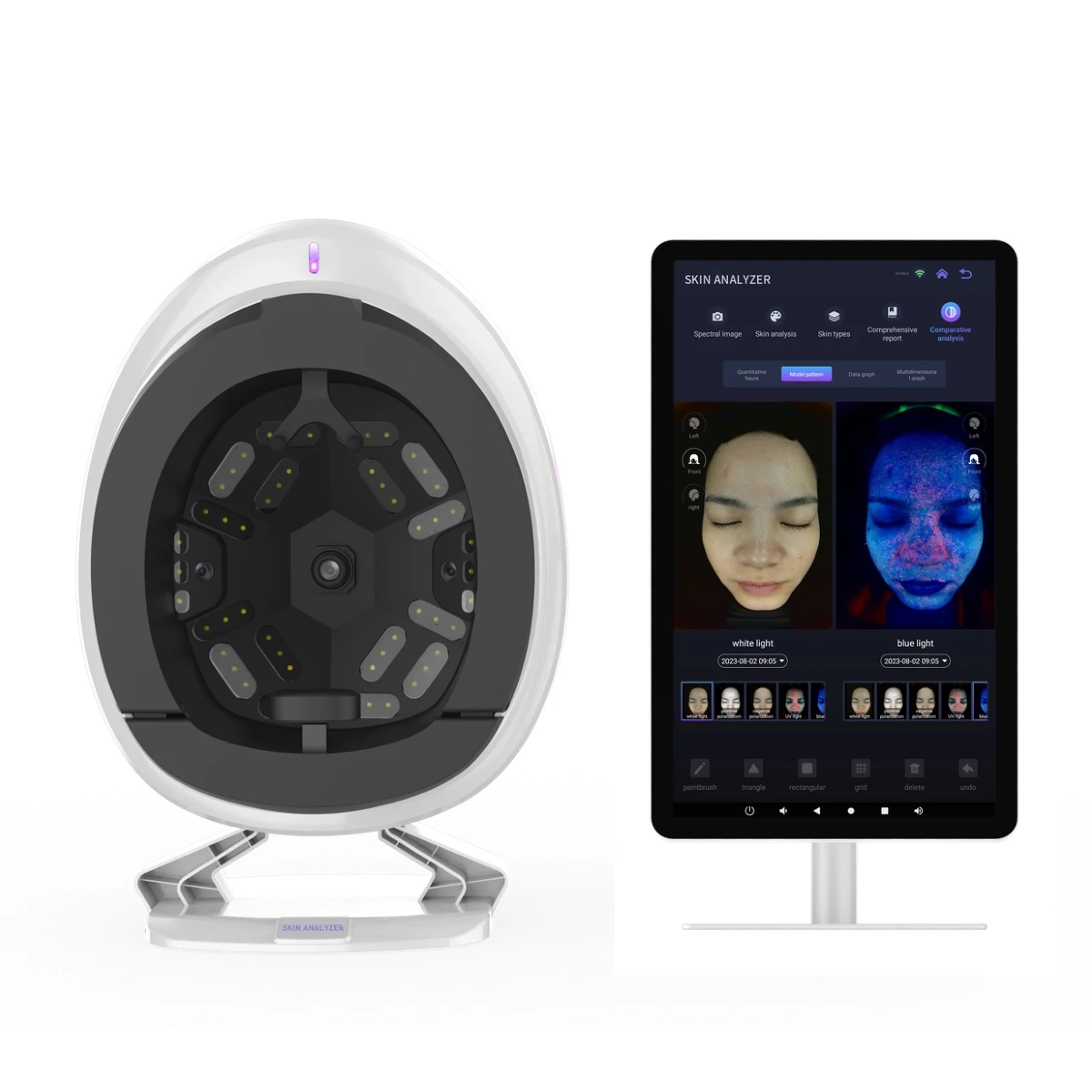Introduce
There’s a widespread consensus in the beauty industry that every beauty salon, clinic, or spa needs a good skin analyzer. Beauticians and doctors can use skin analyzers to diagnose and analyze patients’ skin issues, as well as compare before-and-after skin analysis (to examine underlying skin changes). Professional data provides patients with a clearer understanding of their skin condition. Effective treatment and professional examinations build patient trust, encouraging them to pursue further improvements and treatments.
However, the current market for skin analyzers is highly variable, making selection difficult for aesthetic clinics. Most skin analyzers will put a lot of effort into the machine shell to give the skin analysis machine a good design, such as sci-fi shape, scary images, cool AI and cheap price.
However, the most important aspect of a skin analyzer isn’t its shell design. The quality of the device itself is paramount. Some low-priced skin analyzers have poor pixel count and spectral image quality, making them incapable of helping doctors effectively diagnose and compare treatment outcomes. The lack of skin analysis reports provided by AI makes it impossible to professionally display the overall condition of the patient’s skin, and the treatment plan cannot be set in advance, which is not conducive to subsequent laser and skin care treatments.
So what constitutes a high-quality and effective skin analyzer?
Today, Liton Laser will introduce you to a high-quality skin analysis machine with 8-spectrum imaging, AI data analysis, 8 skin issue detection indicators, and the ability to preset products in advance. The price is the lowest among skin analyzers of the same quality.
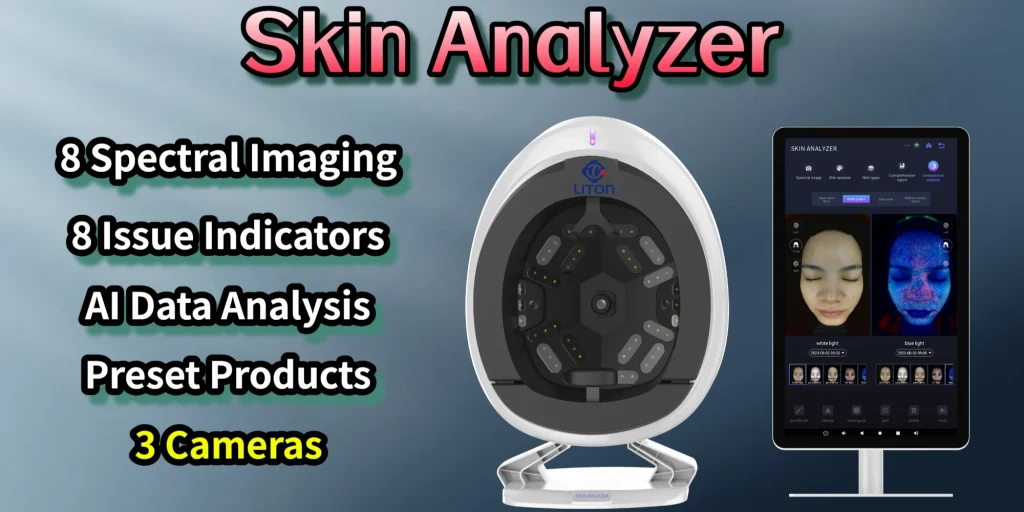
Skin Analyzer Types
Magnifying Light Analyzer
There are a large number of low-priced skin analyzers on the market. These typically use a home SLR camera and are magnifying light-type devices. They can detect surface issues but cannot see deeper into the skin. They also lack analysis results and reports, and can only take photos and view facial skin details.
AI Analyzer
The AI skin analyzer is a high-quality analysis machine on the market. It usually uses multispectral imaging technology to take pictures of the surface and deep details of the patient’s facial skin, and then uses AI algorithm analysis to detect 8 key indicators of problems. Finally, a professional skin analysis report is generated, allowing beauticians or doctors to accurately understand the patient’s skin condition and determine the treatment plan.
Skin Analysis Core Technology
1. Spectral Imaging
Professional skin analyzers typically use multispectral imaging technology to capture facial images of patients for subsequent analysis and testing. Commonly used spectrums are as follows:
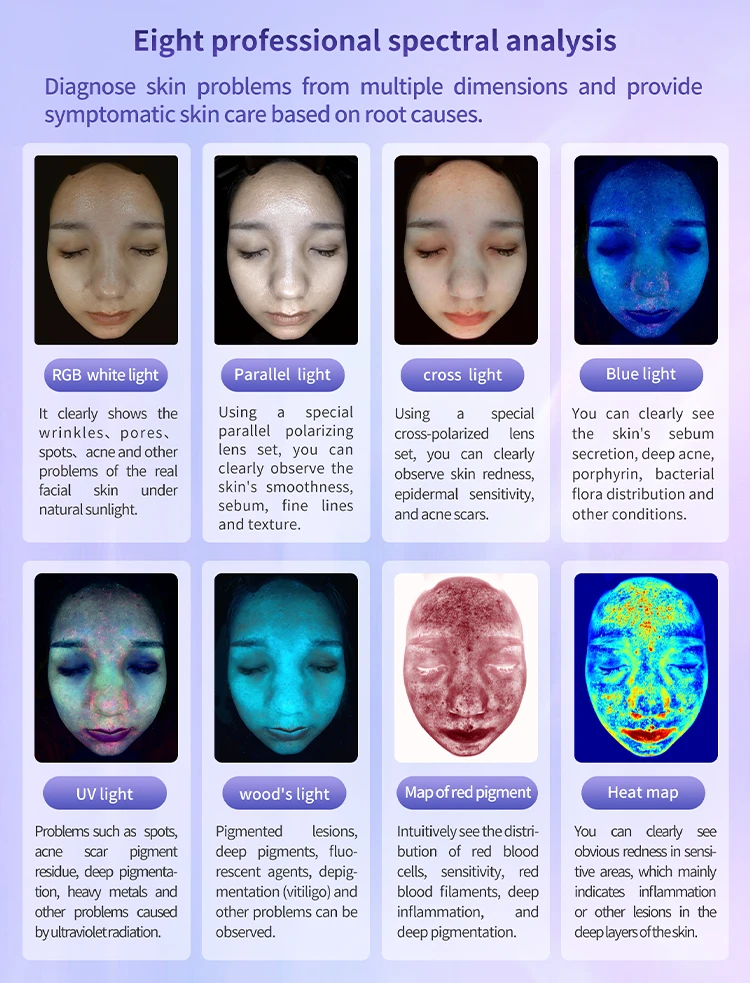
- RGB White Light
- Parallel Polarization
- Cross-polarized Light
- Blue Light
- UltraViolet Light
- Wu’s Light
- Composite Light/Red Pigment Map
- Composite Image/Thermal Map
- Synthetic Light/Brown Spectrum
2. Key Skin Issue Indicators
Eight skin issue indicators are established: surface spots, UV spots, brown spots, pores, texture, wrinkles, red areas (sensitive trends), and porphyrin. When the patient’s spectral image is completed, the skin condition of the image is compared with the skin indicators to confirm the patient’s existing and expected facial skin issues.
3. AI Skin Analysis
Professional facial analyzers are usually combined with AI technology. After using 8-spectrum testing, a professional spectral image will be formed. Then, using 8 key skin issues as indicators, AI data judgment is used to check the spectrum and indicators to confirm the patient’s skin surface and deep-seated conditions, and provide professional data support for subsequent skin reports.
4. Intelligent Analysis Report
By combining spectral images, skin indicators, and AI calculations, a professional skin analysis report is ultimately generated. In addition to the patient’s spectral image, the report also includes basic information such as facial skin issues, skin type, and skin color. Treatment recommendations are also generated, including skincare products and laser treatments. (PS: Report information can be set on the data management website, and treatment products and lasers can be preset)
The skin analysis report will propose the correct treatment plan for the following skin issues:
- Moisturizing treatments for dry/dehydrated skin.
- Oil-control solutions for oily or acne-prone skin.
- Soothing solutions for sensitive skin or rosacea.
- Laser treatments for hyperpigmentation/dark spots.
Ps: And it needs to be emphasized that sun protection is important for all types of skin treatments.
Skin Analyzer Working Theory
The principle of spectral skin analysis is based on analyzing the reflection, transmission, and absorption characteristics of skin tissue using different spectra. This method uses light of a specific wavelength to illuminate the skin and assesses the skin’s condition and characteristics by measuring and analyzing the spectral changes after the light interacts with the skin. The following are the main theories behind spectral skin analysis:
Spectral Selection and Skin Composition
Spectral testing of the skin involves irradiating light at different wavelengths, typically matching the absorption characteristics of specific skin components. For example, melanin strongly absorbs ultraviolet and blue light, while hemoglobin has characteristic absorption peaks at specific wavelengths within the visible spectrum (such as 540nm and 580nm). By selecting these wavelengths for irradiation, the detection of melanin, hemoglobin, and other components in the skin can be more targeted.
Reflectance and Transmission Spectral Analysis
When light strikes the skin, some light is reflected from the surface, while some penetrates deeper into the skin. Both reflectance and transmission spectra contain a wealth of skin information. By measuring the reflectance spectrum, surface skin conditions such as spots and wrinkles can be assessed; while the transmission spectrum provides more detailed information about the deeper structure of the skin, such as vascularity and skin thickness.
Spectral Quantitative Analysis
Spectral testing is not limited to qualitative analysis; quantitative spectral analysis can also be used to accurately assess the content of various components in the skin. This often involves complex mathematical models and algorithms to extract useful information from spectral data. For example, spectral feature libraries for components such as melanin and hemoglobin can be established, and chemometric methods can be used to analyze and quantify spectral data.
Multispectral and Comprehensive Assessment
Modern spectral testing equipment often utilizes multispectral technology, which simultaneously uses multiple wavelengths of light for illumination and detection. This approach allows for a more comprehensive assessment of skin condition and characteristics, reducing the potential errors and limitations associated with single-wavelength testing. Furthermore, combining multiple spectral data with image processing techniques allows for a more refined and comprehensive skin assessment.
Skin Color Detection
The whiteness of the skin should be determined by exposing the skin with two LEDs and then observing the reflection. The photosensitive element in the middle of the probe receives the light and determines the whiteness of the skin by the brightness, thereby determining the patient’s skin color.
Skin Moisture Test
Bioelectric Impedance Measuring Technology (BIM) is a non-invasive testing technique that uses the electrical properties (impedance, admittance, dielectric constant, etc.) of biological tissues and organs and their changes to extract biomedical information related to human physiological and pathological conditions. Changes in the moisture content of human skin will cause changes in its impedance characteristics (especially capacitive reactance). Therefore, by utilizing this principle, we can use electronic measurement technology to detect the impedance characteristics of local skin, thereby reversely calculating the amount of water in the skin and ultimately determining skin hydration.
Skin moisture is measured by measuring the skin resistance between two electrodes. The two electrodes generate a small current. The skin itself has bioelectrical impedance, which is used to determine skin moisture.
Benefits of Skin Analyzer
1. Machine Benefits
The visia skin analyzer has a pathological analysis system and software that captures and analyzes facial images, which can form a more accurate treatment plan, allowing doctors and patients to see skin issues more intuitively, and can form customer files to track treatment results in a sustainable and effective manner.
- Convenient and fast: In less than two minutes, a few flashes of light reveal your skin’s inner and outer flaws.
- Professional and personalized: A database specifically created based on the skin characteristics of Asian women allows for targeted testing of skin types across different age groups.
- Enhanced diagnosis: Comprehensively assesses skin pigmentation, pores, wrinkles, skin smoothness, subcutaneous blood vessels, porphyrins (bacteria accumulated in pores), UV spots (sun spots), and sun damage.
- Public data: After the VISIA skin analysis is completed, the test data can be stored and printed on the computer without worrying about the data being unilaterally modified.
2. Benefits of Use
Many skin treatments don’t produce immediate results; the improvements they bring to our skin are gradual. During this process, we can’t see the underlying changes with our naked eyes. A high-performance skin analyzer can intuitively display these changes in a digital form, eliminating the need to rely solely on personal subjective judgment of the treatment’s effectiveness. Objective skin analysis results have the following benefits:
- Avoid unnecessary medical disputes and enhance trust between doctors and patients;
- Help patients identify potential skin issues, enabling them to better cooperate with treatment and post-operative care;
- Give patients a visual representation of ongoing skin changes, boosting their confidence;
- Help doctors adjust treatment plans based on the patient’s current skin condition and concerns;
- Predict potential changes in the patient’s condition after treatment, thereby facilitating successful transactions.
Suitable for People
Skin analyzers are used to monitor skin conditions and are suitable for people with skin problems such as spots, pores, wrinkles, porphyrins, and UV damage, as well as those who have undergone skin care and are currently observing the effects of treatments, and those who want to identify their skin conditions. Therefore, skin analyzers are typically used in the following scenarios:
Beauty Salons & Spas
As a popular choice for beauty treatments, beauty salons and spas usually need to receive many beauty patients. The first step in treatment is often to identify skin issues. Skin analyzers can help beauticians analyze the patient’s skin information and provide a basis for more treatment and improvement plans.
Professional Cinics
Experienced doctors will never judge based on the naked eye alone. They will use skin analyzers and conduct in-depth facial consultations to quantify existing and potential problems in the deep and shallow layers of the skin from various dimensions such as pigmentation, skin elasticity, and contours.
Surgical Hospitals
Hospitals that provide surgical treatment also need high-quality skin analyzers. They can detect and analyze the patient’s skin condition in advance before cosmetic surgery, and resolve potential skin issues during surgical treatment.
Home Personal Use
Skin analyzers are also commonly used at home. They can be used to detect and analyze one’s own skin condition, identify skin issues, and then purchase appropriate skin care products to treat and improve the skin.
Skin Analysis Process
- Makeup Removal: Makeup removal is essential, and your face should be dry.
- External Light Source: Maintain a consistent light source.
- Shade Cloth: Block glare from clothing.
- Headband: Cover bangs, sideburns, and other areas of your forehead to keep them free of loose hair.
- Disinfection: Clean the chin and forehead rests.
- Sitting Position: Align your body with your midline, tilt your chin forward 100-120 degrees, and place your chin in the chin rest groove. Place your forehead against the two points on the top.
- Enter patient information: The networked skin analyzer supports the customer file function, which can enter the patient’s basic information. Every future skin analysis will be recorded in the patient’s file to form an exclusive skin report guide.
- Photography: Place your face on the device’s small rest, close your eyes, and remain expressionless. Flashes are taken from the left, center, and right sides.
- Skin Report: After the device takes a photo, it compares and analyzes the spectral image with AI to identify the patient’s skin issues. A skin report containing complete skin information and treatment recommendations is generated on the iPad.
Skin Analyzer Use Cases
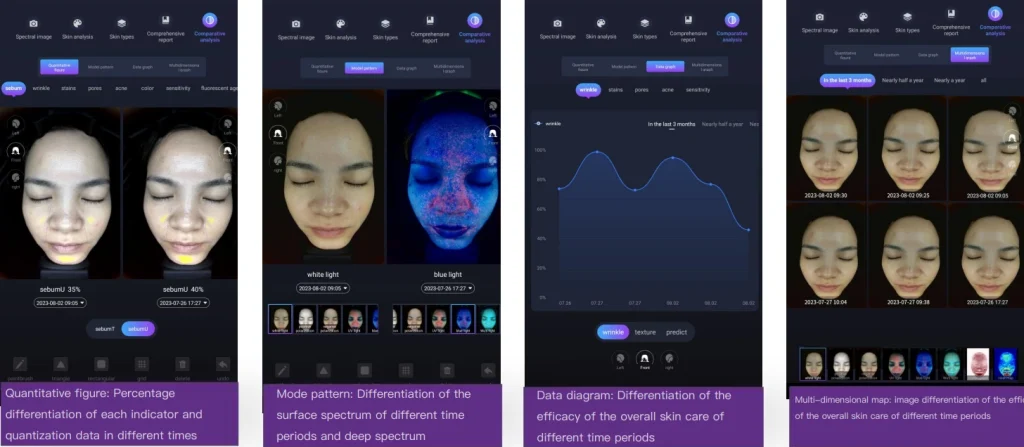
The analysis report from a professional skin analyzer includes quantitative images, model patterns, data graphs, and multi-dimensional graphs of the patient’s facial skin. It analyzes the patient’s skin condition from multiple dimensions, including skin type, skin color, hydration, surface issues, and potential deeper issues. It also displays different spectral graphs and can predict potential future skin issues. The entire facial data collection and analysis process is open to the public, and ultimately, through AI algorithms and big data, professional treatment and improvement plans are developed.
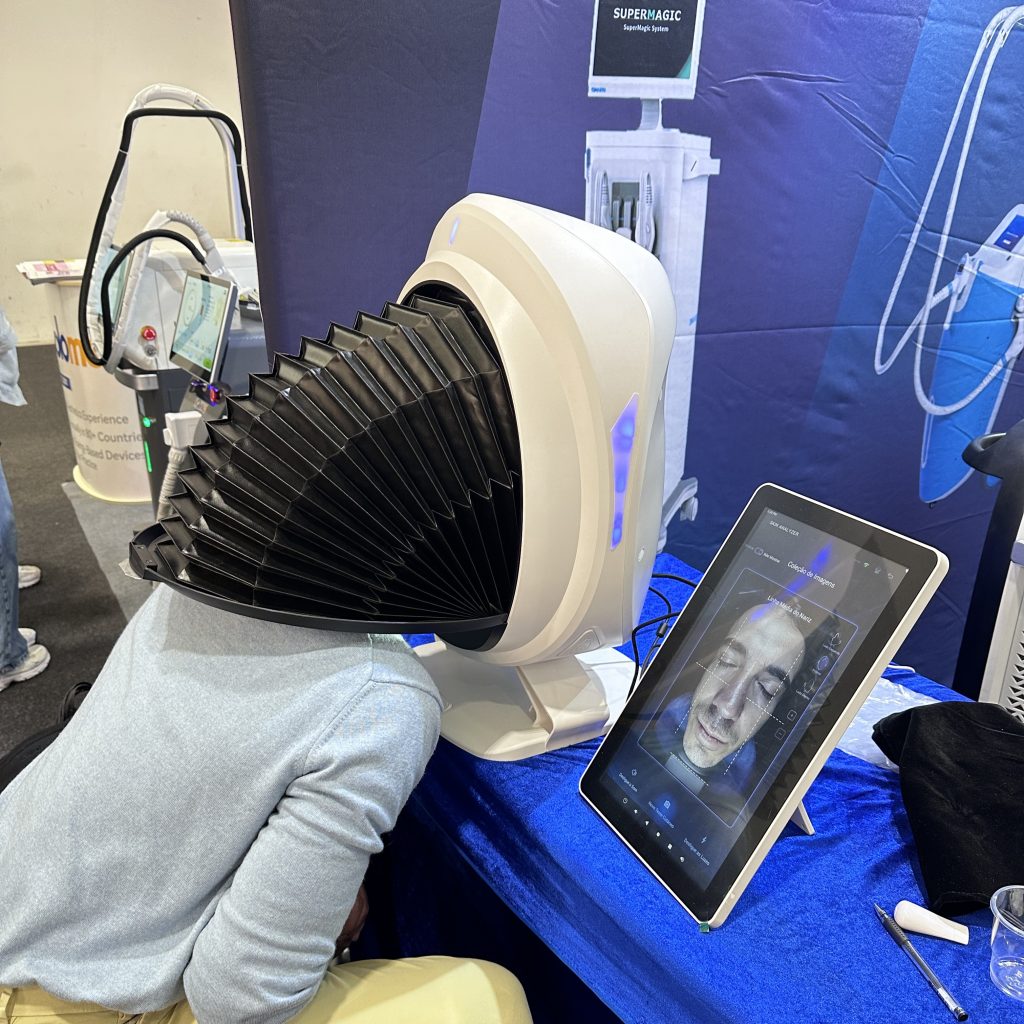
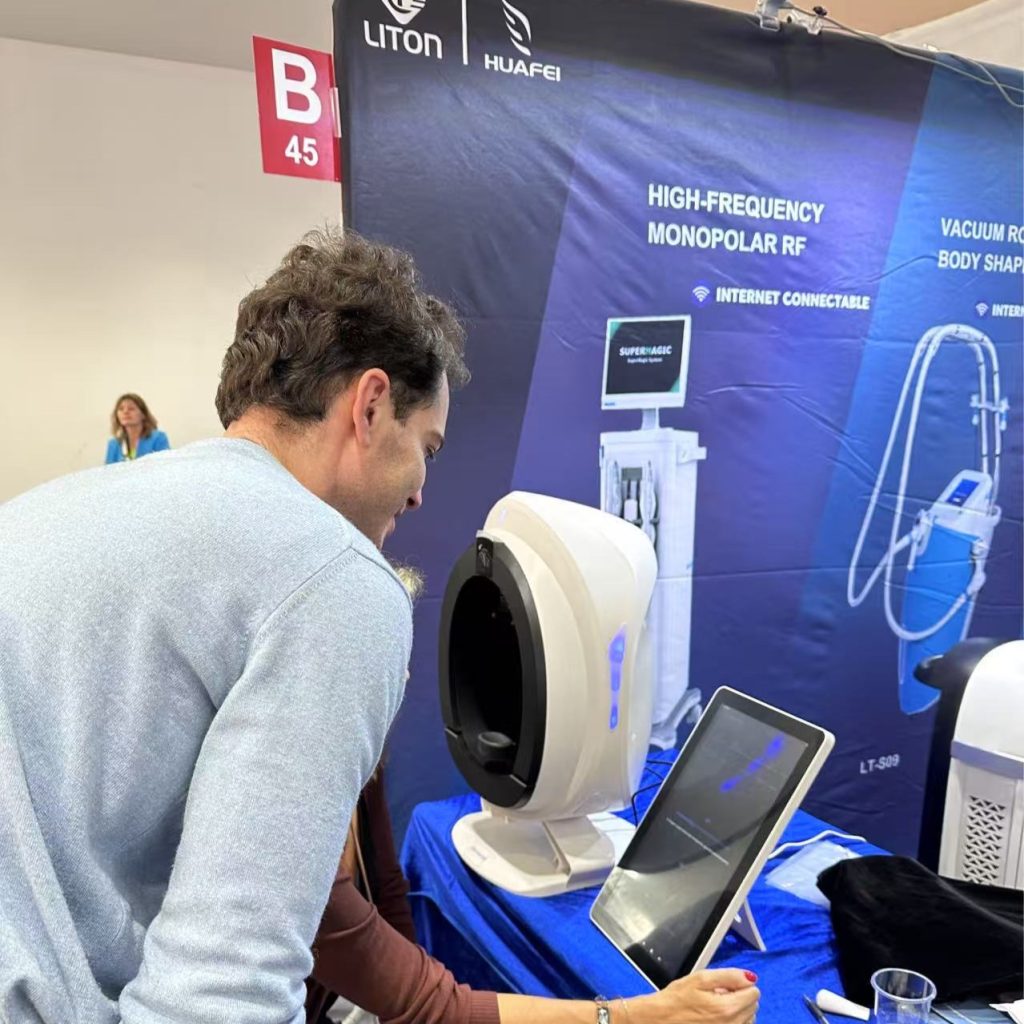
The two images above show Liton Laser at Cosmoprof Worldwide Bologna 2025. An Italian visitor was so interested in the skin analyzer that he couldn’t wait to try it out and see his skin report. The left image shows a customer taking a photo using the skin analyzer, while the right image shows him reviewing his skin analysis report.
Skin Analyzer Ranking
| Skin Analyzer | Features |
| VISIA Gen8 | Multispectral imaging technology, patented RBX technology, AI intelligence, 3D imaging |
| Observ 520x | AI intelligent analysis, 360 light and shadow aesthetic technology |
| AISIA Skin Analyzer | 8-spectrum imaging, 8 skin indicators, AI intelligent analysis, 48 million pixels, preset products |
| Zemits VeraFace Skin Analyzer | 15-second quick scan, AI analysis, 3-spectrum imaging |
| BomTech A-ONE W Skin Analyzer | 3 spectral imaging, 8 skin indicators |
| Derma-Vu Photographic System | 8 spectral imaging, 17 skin indicators, 3D handpiece |
| Opatra DOME | 3-spectrum imaging, 10 skin indicators, 20 million pixels |
| Canta Esthetic M9 Skin Analyzer | 3 spectral imaging, 12 skin indicators, and analysis of 10 skin issues. |
| AM-211 Skin Analyzer | 5-color spectral imaging, AI intelligent analysis, 12 million pixels |
| SkinScope | 2 Spectral imaging, fluorescence technology, LED lighting |
The table above, provided by Liton Laser (a professional beauty equipment manufacturer), lists the top 10 skin analyzers in the world, taking into account their popularity and influence, as well as the quality and price of the devices themselves.
Buy the Best Skin analyzer
Whether you work in an aesthetics company, beauty salon, skin clinic, training school, or any other industry, and whether you’re a nurse, beautician, or doctor, choosing a high-quality, highly configured, and cost-effective skin analyzer is essential for most.
If you’re looking for a top-tier skin analyzer at the lowest price in its class, Liton Laser recommends the AISIA Q Series Skin Analyzer. It offers the same features as the Observ 520x and VISIA Gen8, but at just one-fourth and one-eighth the price, respectively.
1. Skin Analyzer Q1
The Q1 Skin Analyzer features 8 spectra, 1 industrial camera, 8 skin indicators, 36 megapixels, product presets, and professional skin reports. Its relatively affordable price makes it suitable for those on a budget.
If you would like to purchase the Q1 Skin Analyzer, please contact us on the Q1 Skin Analyzer page.
2. Skin Analyzer Q2
The Q2 Skin Analyzer features 8 spectra, 3 industrial cameras, 8 skin indicators, 48 megapixels, product presets, and AI-powered skin reports. While priced higher than the Q1, it’s ideal for those seeking high-quality products.
If you’re interested in purchasing the Q2 Skin Analyzer, please contact us on the Q2 Skin Analyzer page.
Future Trends
Skin analyzers have a role to play whether used by individuals, beauty salons, or dermatology clinics. Scientific beauty and targeted skin treatments will be essential in the future, and therefore, the future trend for skin analyzers is expected to be upward.
Home Use
For the average consumer, a skin analyzer can be simply thought of as a CT scanner for the facial skin. It diagnoses skin problems quickly and provides accurate monitoring data, allowing you to truly visualize your skin’s current state. This intuitive data provides a clear overview of your skin’s condition, allowing even the most average person to understand what they are seeing. This helps us understand our skin’s condition and allow us to tailor skincare regimens based on specific skin concerns.
A skin analyzer can be said to be a mirror that reveals problematic skin and a guardian of skin health.
Beauty Salon Use
With evolving consumer attitudes, more and more patients in beauty salons and clinics are opting for more professional and technologically advanced skin care methods. Skin analyzers play a crucial role in the beauty industry’s pursuit of professional and scientific beauty. They serve as the intelligent brain for attracting customers, acquiring new customers, retaining them, and increasing sales, making them an essential beauty device for boosting sales.
More Skin Analysis Articles
- Exploring the VISIA Skin Analyzer: The Truth About Skin
- Professional Skin Analysis Machine 3D Skin And AI Face Technology
FAQs About Skin Analyzer
Q1: What does a skin analyzer do?
Skin analyzers can provide the following benefits for beauty salons or clinics:
- Essentially Necessary: A skin test is the first step in skincare routines. A skin analyzer is an essential device in every beauty salon, spa, or clinic’s skin care program.
- Personalized Skincare: Helps identify skin concerns early on, provides theoretical support for personalized skincare, and customizes a skincare program tailored to the patient’s skin.
- Building Trust: Builds trust with patients, using scientific equipment to determine the right treatment plan for them.
- Issue Detection: Helps customers record their skin’s dynamics over time, creating a personalized profile that documents the underlying changes before and after treatment.
- Combined Skincare: Combined with other lasers or skincare products, skincare routines can be optimized.
- Professional Management: Helps beauty salons and spas categorize and manage patient skin issues, as well as manage treatments and spending tiers.
- Sales Assistance: Combined with a beauty salon or clinic’s treatment offerings, this can boost overall store performance by over 50%.
- Reducing Customer Complaints: Visually compelling data makes skincare results clear at a glance, enhancing the customer experience.
Q2: What skin issues can a skin analyzer detect?
The Liton Laser Skin Analyzer can detect the following skin issues:
- Inflammatory skin issues. Sensitive skin, thinning skin, dilated capillaries (redness), acne, etc.
- Pigmentary issues. Pigmentation issues. Pigmentation spots, melasma, sun spots, freckles, age spots, café-au-lait spots, nevus of Ota, uneven skin tone, dark circles, hyperpigmentation, etc.
- Hair issues. Facial hair, lip hair, and body hair, etc., can help provide data for hair transplants.
- Wrinkle issues. Fine lines, dry lines, wrinkles around the mouth, wrinkles before the ears, nasolabial folds, forehead wrinkles, ridges, tear troughs, nasal dorsum wrinkles, and marionette lines.
- Aging issues. Sagging skin, roughness, sunken temples, and drooping cheeks.
- Pore issues. Enlarged pores, clogged pores, blackheads, etc.
Q3: How does the skin analyzer technology work and how are results calculated?
The skin analyzer uses spectral imaging technology and AI intelligent analysis technology to analyze the user’s facial surface and deep-seated skin issues based on multiple skin indicators.
Q4: Is there a cost to use a skin analyzer app or device?
Skin analyzer apps are usually provided free of charge, but the device needs to be purchased.
Q5: How can I get the most accurate results from a skin analyzer?
To obtain the most accurate facial skin information, testers should remove makeup and cleanse their face before taking photos, so that the skin analyzer can capture the most realistic skin condition.
Q6: What are the best techniques for proper facial and eye alignment during a scan?
With the Liton Laser Q2 Skin Analyzer, you no longer need to worry about the position of your face and eyes. With three cameras, you can capture 360° details of your face without any blind spots.
Q7: Can I use flash or selfie cameras with the skin analyzer?
When the skin analyzer is taking pictures, the camera will automatically flash, so patients do not need to prepare a selfie camera.
Q8: Why might results vary between scans?
The scanning results of the skin analyzer will change. Different environments, different times, different brightness, whether or not you are wearing makeup, etc. will affect the final scanning and analysis results.
Q9: How can the skin analyzer help with skincare recommendations or business?
The skin analyzer scans a patient’s face photo and generates a skin report on the iPad. This report not only lists skin issues but also provides treatment recommendations. Treatment recommendations can be pre-configured. Beauticians and doctors can pre-set treatment plans on the software’s website, pre-setting their own skincare products or lasers. This helps beauty salons or clinics connect with other services and treatments after the skin analysis.
Conclusion
High-quality skin analyzers (VISIA Gen8, Observ 520x, AISIA Q2 Skin Analyzer) are all industrial-grade cameras. They typically utilize multispectral imaging technology, multiple skin indicators, and AI-powered intelligent analysis to generate professional skin reports. These reports provide comprehensive information about the patient’s skin (skin tone, skin type, moisture content, skin issues, etc.), predict future skin conditions, clearly visualize both surface and underlying facial issues, and offer professional solutions (skincare products and laser treatments).
Skin analyzer functions: Provide early warning and accurate diagnosis of skin issues. Using data to assess skin condition, they reveal skin issues that are difficult to detect with the naked eye. Determine the most realistic facial skin issues from a scientific analysis perspective.

